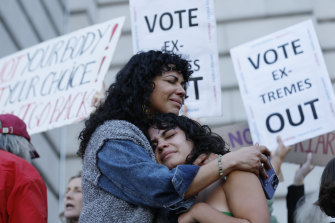‘Cataclysmic and chaotic’: Abortion battle lines drawn as legal floodgates open

The impact has been swift and severe.
Within days of the US Supreme Court overturning the constitutional right to have an abortion in America, clinics across the south and midwest have continued to shut their doors, leaving countless women scrambling for healthcare.
Not-for-profit groups that arrange for patients to obtain abortion pills have been inundated with requests, expanding their teams and setting up mobile clinics on state borders to reduce the travel burden for patients.
And the battleground over reproductive rights has now turned to courthouses across the country, as those opposed to abortion move to enact statewide bans while those in favour try to buy more time.
Mitzi Rivas, left, hugs her daughter Maya Iribarren during an abortion-rights protest at City Hall in San Francisco following the Supreme Court’s decision to overturn Roe v. Wade.Credit:AP/Josie Lepe
In Louisiana, a district court on Monday (US time) temporarily blocked “trigger” laws that would have made nearly all abortions illegal in the state, after a coalition of providers filed a lawsuit arguing the ban was unconstitutional. The ruling is in effect pending a July 8 hearing.
In Florida, health care providers also went to court on Monday seeking an injunction to block the state’s new ban on abortion after 15 weeks of pregnancy, which was previously signed by Republican Governor Ron DeSantis and due to take effect on Friday.
And in Georgia, an appeals court was set to decide within days whether to invoke a 2019 law that has been on the shelf for years, which could now effectively outlaw abortions after six weeks of pregnancy.
Both sides of the debate warn it’s only the beginning.
“I can’t emphasise enough what a cataclysmic change this will be, or how much chaos we will see in coming days and months,” says Julie Rikelman, the litigation director at the Centre for Reproductive Rights, who argued the Mississippi case at the heart of Friday’s Supreme Court ruling.
“We are on the verge of what may be the biggest public health crisis that we have seen in decades.”
President Joe Biden speaks at a G7 side event in Germany alongside German Chancellor Olaf Schulz and Prime Minister of Italy Mario Draghi Credit:Sean Gallup/Getty Images
As the reality of life in a post-Roe v Wade world began to sink in this week, President Joe Biden was in Europe for a week of summits, trying to find ways to lower food and gas prices while keeping allies in lockstep over the war in Ukraine, which is now into its fifth month and fading from the minds of many Americans.
But even as he sought to show strength on the global stage, the question of what happens next couldn’t have been far from Biden’s mind.
It’s hard to overstate how much pressure the White House is under to do something proactive to fight for abortion rights – and to do it fast.
Abortion rights demonstrators chant outside the US Supreme Court in Washington DC on Saturday June 25, 2022. Credit:Bloomberg
Last week’s decision was a monumental victory for anti-abortion activists – some are already pushing to ban abortion nationwide, while others are pressuring the states to stop people from accessing abortion drugs or from crossing state borders for treatment in places where it remains legal to terminate a pregnancy.
Pro-choice activists, on the other hand, are calling for a wave of ambitious reforms to protect what’s left of abortion access in the US. Among them is a push to expand the number of justices on the court (a contentious proposal known as “court packing” that Biden has ruled out); eliminating the Senate’s filibuster rule so abortion rights can be codified without needing a super majority of 60 votes (this will not happen); or opening abortion clinics on federal lands (which will prove difficult in Republican states).
Two leading Democratic senators in the women’s reproductive rights space – progressive stalwart Elizabeth Warren and former Planned Parenthood staffer Tina Smith – have also urged Biden to declare a public health emergency, which they say would help protect access and unlock “critical resources and authority that states and the federal government can use to meet the surge in demand for reproductive health services.”
So what exactly does the Biden administration plan to do in wake of the Supreme Court’s decision, given the few levers it has?
First, it will seek to prevent states from banning pills used for medication abortion, such as mifepristone, that have been approved by the federal US Food and Drug Administration. As Biden said has said, any attempt to ban such pills would be “wrong and extreme and out of touch with the majority of Americans”.
Secondly, Biden asked his two relevant departments, the Department of Justice and the Department of Health, to protect access to abortion through federal laws. One option involves using the Freedom of Access to Clinic Entrances Act, which prohibits anyone from obstructing access to reproductive health services through violence, threats, or property damage in states where it remains legal.
And thirdly, the administration has declared that federal agencies must continue to provide reproductive health services “and federal employees who carry out their duties by providing such services must be allowed to do so free from the threat of liability”.
To back this up, the Department’s Office of Legal Counsel has issued advice showing employees would not violate the Assimilative Crimes Act if they continue to provide services and therefore could not be prosecuted under that legislation.
But, beyond tweaking around the edges, there’s only so much Biden can do. Democrats made a symbolic attempt in early May to codify abortion rights into law but like so many other things in Congress, the vote fell victim to an evenly split Senate, where the party doesn’t have the numbers.
The reality is, the White House doesn’t have many other options beyond urging people who support abortion access to vote at the midterm elections in November and return a “pro-choice majority” to the House and Senate.
The bulk of the fight is going to happen at the state level as the Supreme Court’s extraordinary decision opens the floodgates for a wave of litigation from all sides.
To that end, the battle lines have been well and truly drawn.
Most Viewed in World
From our partners
Source: Read Full Article



